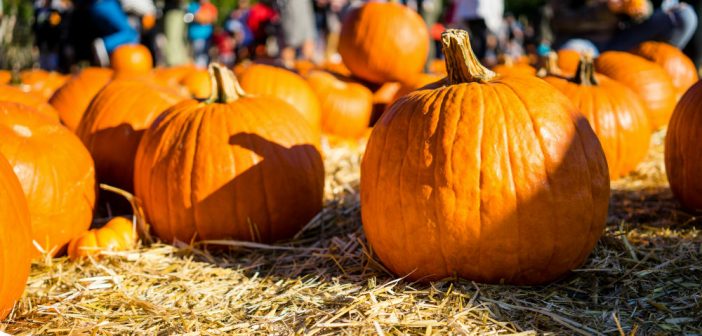October evokes images of ghosts, goblins, trick-or-treaters and of course pumpkins. Pumpkins can be carved, displayed and eaten. But how do you know which pumpkin is good for what? Here are some rules on how to select the perfect pumpkin this fall.
Choosing a Pumpkin
Pick a pumpkin fresh from the farm. Be sure to take gloves and clippers with you (also take a wagon to cart it to the car). If you are going to buy a pumpkin from a supermarket, avoid ones bruised from shipping.
Pick a Firm Pumpkin
Look for the firmest pumpkins that you can find. Reject ones with soft spots, nicks, or cuts because they will rot quickly. Double check the bottom, it might be damp and soft from sitting on the ground.
Inspect the Stem
A fresh pumpkin will have a green stem at least one inch long and the area around the stem will be firm. A dull color around the stem could mean there’s a problem inside. Don’t lift the pumpkin by its stem, it can break easily and damage the pumpkin.
Color Matters
Select a pumpkin with good color. The color should be consistent and not dulled, unless you are choosing a pumpkin for cooking when dullness is less of a concern. Ditch pumpkins with green spots or brownish scabs from insect damage. Orange fruits make a classic jack-o-lantern, but white-skinned pumpkins can give your carving a ghostly look perfect for Halloween. The white Lumina variety can be used for carving and its sweet orange flesh which can be used for cooking too.
Pumpkin Varsities
Some pumpkins are grown specifically for carving, like the Jack-O-Lantern variety. Ghost Rider and Baby Pam, are small, sweet and good for cooking.
Choosing a pumpkin for carving
Have an idea of what you’re carving so you know what shape you need, including perfectly round or slightly oblong. If you plan on using a stencil, bring it along with you when selecting a pumpkin.
Check the Shell
Pick a pumpkin with a light thin shell, this will makes it easier to carve and have a better cavity for the light. Thick shells can block the light and diminish the effect from the design. Your pumpkin should also sound hollow when you knock lightly on the outside.
Check the Surfaces
Pumpkins with smooth flat surfaces are easier to carve. Avoid pumpkins with thick ribs, which make carving more difficult. Also check its balance to make sure the pumpkin won’t rock or tip when you place it on a flat surface.
Choosing a pumpkin for cooking
Fat Pumpkins
Look for small, fat pumpkins (cooking pumpkins usually weigh between four and eight pounds.) Fat pumpkins that feel heavy for their size have the most flesh and will store well. New England Pie and Small Sugar pumpkins are great varieties for cooking.
Squash Substitutes
Some varieties of winter squash make a good substitute for pumpkin including butternut or crook-necked squash. Squash flesh is less stringy, full of flavor and easy to peel. Did you know that commercial canned pumpkin is actually made from squash?
Freeze it
Pumpkin and squash freeze well, so you can enjoy fall flavors throughout the winter. You can bake, mash, portion out and store pumpkin in your freezer so it’s ready for a quick pie, quick bread, soup, or ravioli.
Be Patient
The longer pumpkins sit, the sweeter they get, so don’t be afraid to let your pumpkin sit.
Choosing Pumpkins for Displays
Variety
Go wild with your fall arrangements. Select a variety of pumpkins including small, large, warty, orange or white, orange with lighter orange ribs and speckled green gourds. Add leaves preserved with glycerin or add Indian corn for a splash of color and texture.
Paint them
If you have small children, painting can be a safer activity than carving. White and lighter colored pumpkins are great for painting because the paint colors will look more vibrant. Use acrylic paints, they dry quick and are easy for cleanup.
Preserving Pumpkins
Keep your pumpkins frost free. Pumpkins decay quickly if they are subjected to frost; bring your jack-o-lanterns inside when temperatures drop. There are special products that preserve pumpkins so they last longer. Soak a carved pumpkin in a mixture of one teaspoon of bleach to one gallon of water for eight hours. Invert it to drain out any excess liquid before you display it.
Mulch it
After Halloween, cut up your pumpkin and put it into a compost bin. If you don’t have a compost bin, bury it in your garden to nourish the soil for the coming year.
Whether you’re carving a jack-o-lantern, eating pie, or admiring your fall arrangement, pick the perfect pumpkin and enjoy the fall season.









